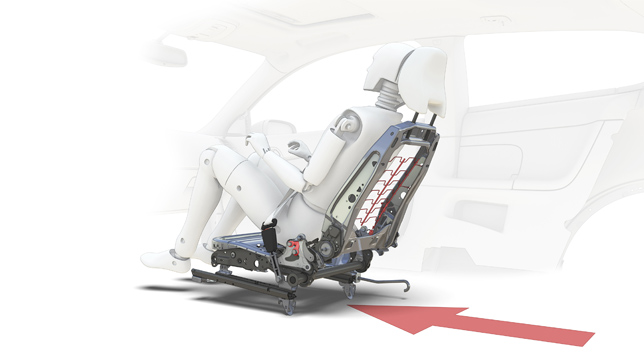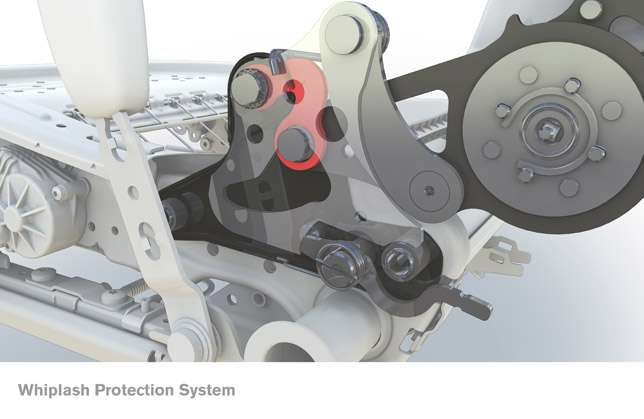Volvo Cars receives highest rating for its unique whiplash protection
EuroNCAP has instituted a new assessment protocol for evaluating the degree of whiplash protection offered by passenger cars in rear-end collisions. The Volvo XC60 was one of the few models to receive the highest rating. For the first time, EuroNCAP is now conducting tests in order to rate the whiplash protection offered by cars. Twenty-five cars were tested in the initial round. The XC60, with Volvo's unique Whiplash Protection System (WHIPS), was one of five cars to receive the highest rating.
A number of different tests are included in the evaluation procedure. The seat's geometry is first measured, for example, the position of the head restraint, in order to determine how well the seat can protect against injuries in a collision. Three tests are then conducted in a testing rig, with varying degrees of collision severity. This rig is used to simulate a situation in which a stationary car is subjected to a rear-end collision. Finally, the results are evaluated and the car is graded on a scale of red, orange and green where red is poor, orange is marginal and green is good.
"Our latest model, the Volvo XC60, performed well in all of the tests and was given an overall rating of green," says Thomas Broberg, a safety expert at Volvo Cars.
The Volvo XC60 also received the highest rating of five stars in EuroNCAP's Adult Occupant Protection tests, which include front and side impacts.

Common injury that causes great suffering Whiplash injuries are one of the most common types of traffic injury and occur primarily in rear-end collisions. If whiplash injuries can be prevented, society avoids considerable expenses and the amount of suffering by the individual is reduced.
"The reason for neck injuries is the very rapid movement between the head and body," explains Thomas Broberg. "This makes it vital for the whiplash protection system to support the entire back and head and to help the person's head move together with the torso. The design of the seat's backrest and a head restraint that is sufficiently high and positioned close to the head are also important factors."

WHIPS reduces risks by half Volvo's WHIPS is a form of protection integrated into the front seats which supports the seat occupant's entire back and head in a rear-end collision. This protective system cushions the movement through energy-absorbing deformation elements between the backrest and seat cushion. If a rear-end collision occurs, the backrest follows the occupant's rearward movement in order to reduce the forces on the neck and spine.
This year marks WHIPS' tenth anniversary. This technology was introduced in 1998 on the Volvo S80 and WHIPS has been a standard feature on all Volvo models since 2000. Thomas Broberg explains that WHIPS' effects are very positive; according to Volvo's Accident Research Team, this system reduces the long-term effects of whiplash injuries by half.
Research based on actual accidents Volvo's work with safety is always based on real-life traffic accidents. Through Volvo's own Accident Research Team and tens of thousands of crash tests, facts are compiled that subsequently form the basis for the development of the safety systems of tomorrow. Helping a driver avoid an accident is naturally the most effective means of reducing the number of people injured or killed in traffic. For instance, the Volvo XC60 is equipped with City Safety, which is a unique feature that helps the driver avoid colliding with the vehicle ahead in slow-moving traffic and other similar situations. EuroNCAP does not currently test safety systems of this type.
"Consumer guidance from an external rating institute that assesses cars' protective safety through standardised tests is good but the most important thing for us is to be able to offer the market's absolutely safest cars in all imaginable situations," concludes Thomas Broberg.













